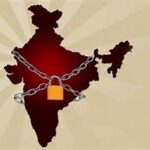The Bharat Bandh of July 2025 stands as one of the most significant nationwide protests in recent years, with over 25 crore workers and employees participating across India. This massive strike, spearheaded by a coalition of central trade unions and supported by farmers’ and rural workers’ organizations, has disrupted key sectors and captured the nation’s attention. In this comprehensive, SEO-optimized blog post, we’ll break down the reasons behind the Bharat Bandh, the impact on daily life, the demands of the trade unions, and what this means for India’s socio-economic landscape.

Table of Contents
- What is Bharat Bandh?
- Why are Trade Unions Protesting?
- Key Demands of the Bharat Bandh 2025
- Impact on Public Services and Daily Life
- Who is Participating in the Strike?
- Nationwide Reactions and Trending News
- Frequently Asked Questions
- [Conclusion: The Road Ahead for Indian Workers]
What is Bharat Bandh?
Bharat Bandh translates to “India Shutdown” and refers to a nationwide strike called by various trade unions, workers’ associations, and, often, farmer groups. The Bharat Bandh on July 9, 2025, is a general strike involving over 25 crore (250 million) workers across sectors such as banking, insurance, mining, transport, and public services.
This protest is not just a one-off event but part of a series of strikes that have occurred over the years, each time reflecting the growing unrest among India’s workforce regarding government policies perceived as anti-worker or pro-corporate.
Why are Trade Unions Protesting?
The core of the Bharat Bandh protest lies in opposition to the central government’s recent labor and economic reforms. Trade unions argue that these reforms, particularly the four new labor codes passed by Parliament, undermine workers’ rights and job security.

Major Issues Highlighted by Unions
- Dilution of Workers’ Rights: The new labor codes allegedly make it harder to organize strikes, extend working hours, and weaken the ability of workers to form unions.
- Privatization and Contractualization: There is strong resistance against the privatization of public sector units (PSUs), outsourcing of jobs, and the increasing use of contract labor, which unions claim erodes job security and fair wages.
- Youth Unemployment: With 65% of India’s population under 35, trade unions highlight the lack of job opportunities for young professionals, citing increased recruitment of retired personnel in government departments as a major concern.
- Ignored Demands: The unions submitted a 17-point demand list to the government, which they claim has been ignored, including the failure to hold the annual Indian Labour Conference for over a decade.
Key Demands of the Bharat Bandh 2025
The trade unions and their supporters have articulated a comprehensive set of demands, reflecting the concerns of both urban and rural workers:
SEO Keywords: labor code repeal, minimum wage India, MSP for farmers, old pension scheme, social security for workers
Impact on Public Services and Daily Life
The Bharat Bandh has had a sweeping impact across India, disrupting essential services and affecting millions of citizens.

Sectors Affected
- Banking and Insurance: Many banks and insurance offices have either closed or are operating with minimal staff, affecting transactions and customer services.
- Public Transport: Bus and train services have been delayed or halted in several states, causing inconvenience to commuters.
- Postal Services: Mail delivery and post office operations have been disrupted in key urban and rural areas.
- Mining and Industrial Production: Coal, copper, and other mining activities have slowed down due to worker participation in the strike.
- Electricity Supply: Power sector workers have joined the strike, raising concerns about electricity supply interruptions in some regions.
- Construction and Rural Work: Construction projects and rural employment schemes have also been affected due to the mass participation of laborers.
What Remains Open?
- Schools and Colleges: Most educational institutions remain open, though some may experience delays due to transport disruptions.
- Private Offices: Private sector offices are largely functioning as usual, though attendance may be impacted in protest-heavy areas.
SEO Keywords: Bharat Bandh impact, public services closed, banking strike, transport disruption, mining strike, electricity strike
Who is Participating in the Strike?
The Bharat Bandh is notable for its scale and the diversity of participants. The protest is led by a coalition of 10 major central trade unions, including:
- All India Trade Union Congress (AITUC)
- Indian National Trade Union Congress (INTUC)
- Centre of Indian Trade Unions (CITU)
- Hind Mazdoor Sabha (HMS)
- Self-Employed Women’s Association (SEWA)
- Labour Progressive Federation (LPF)
- United Trade Union Congress (UTUC)
- Trade Union Coordination Centre (TUCC)
- All India United Trade Union Centre (AIUTUC)
- All India Central Council of Trade Unions (AICCTU)
Farmers’ organizations like the Samyukta Kisan Morcha and rural worker groups have also extended support, organizing rallies and road blockades in rural areas.
Nationwide Reactions and Trending News
The Bharat Bandh has dominated news headlines and social media trends, with widespread coverage of the protests, road blockades, and public reactions. Here are some of the top trending developments:
- Road and Rail Blockades: Protesters have blocked highways and railway tracks in states like West Bengal, Odisha, and Bihar, causing significant delays.
- State-wise Impact: Kerala saw widespread shutdowns of shops and public transport. In Bihar, a simultaneous state-level bandh added to the disruptions.
- Government Response: The central government has maintained that the reforms are necessary for economic growth and job creation, but unions argue these changes favor corporations at the expense of workers.
- Public Sentiment: Social media is abuzz with hashtags like #BharatBandh2025, #TradeUnionStrike, and #WorkersProtest, reflecting both support and criticism of the strike.
Frequently Asked Questions
Q1: What is the main reason for the Bharat Bandh 2025?
A: The main reason is opposition to new labor codes, privatization of public sector units, and lack of job security and fair wages for workers.
Q2: Which sectors are most affected by the strike?
A: Banking, public transport, postal services, mining, electricity, and construction are among the most affected sectors.
Q3: Are schools and colleges closed during the Bharat Bandh?
A: Most educational institutions remain open, but some may experience delays due to transport disruptions.
Q4: How many workers are participating in the Bharat Bandh?
A: Over 25 crore (250 million) workers and employees are estimated to be participating in the strike1235.
Q5: What are the key demands of the trade unions?
A: Key demands include repealing the new labor codes, ending privatization and contractualization, increasing minimum wages, and ensuring job security and social security for all workers.
Conclusion: The Road Ahead for Indian Workers
The Bharat Bandh of July 2025 is a landmark event in India’s ongoing labor movement, highlighting the deep-rooted concerns of workers and farmers about the country’s economic direction. As the nation grapples with the aftershocks of this massive strike, it remains to be seen how the government and unions will address the pressing issues of job security, fair wages, and workers’ rights.
For now, the Bharat Bandh serves as a powerful reminder of the collective strength of India’s workforce and the enduring importance of dialogue between the government and its citizens.
We’d love to hear your thoughts!
- How has the Bharat Bandh affected your city or region?
- Do you support the demands of the trade unions?
- What changes would you like to see in India’s labor policies?
Share your views in the comments below!











Хай всем! Планирую поделиться рядом советов по эффективному поиску печенек в глобальной сети. Иногда бывает, что традиционный поиск не даёт нужных результатов, поэтому важно использовать более конкретные ключевые слова или комбинировать их с дополнительными фильтрами. Допустим, попробуйте подбирать не просто «печеньки», а «превосходные рецепты печенек с шоколадом» или «семейные печеньки без муки».
Помимо этого полезно просматривать на узконаправленные сайты, где представлены рецепты и обсуждения — нередко там куда проще найти точно то, что нужно. Взгляните, например, эта список рецептов может быть полезной: Поиск печенек . Существенное — не стесняться экспериментировать с словосочетаниями и добавлять уточнения, чтобы сузить круг поиска и оперативно найти отличную информацию.
If you’re keen to learn about your color season, identifying whether you correspond to the deep summer palette can truly help enhance your wardrobe and makeup choices. Deep summer color analysis focuses on subdued, cool tones that suit yellow undertone skin and olive complexions, making it smoother to determine clothing colors that bring out your natural beauty. For a free interactive experience, you may wish to try an AI color analysis quiz online—there are some outstanding tools that provide insights without any cost color season .
Grasping your season goes beyond just clothes; hair color trends for 2026 also tie into seasonal color theory, so you can investigate options like cool summer hair color or shades that function perfectly for pale or yellow undertone skin. If you’re wondering “what season am I?” or hunting for a skin tone chart to help your choices, seasonal color palettes and color analysis apps can make the process pleasant and exact. Looking into these resources definitely benefits in figuring out what colors make you glow naturally!
Если планируете поездку в Калининград, нужно учитывать, что балтийское море в этом регионе весьма прохладное — температура моря в Калининграде летом редко достигает выше +18…+20°C. Сезон купания в основном открывается в июне и растягивается до августа, но можно ли купаться в Калининграде в сентябре или октябре, решать вам — вода быстро остывает. Для тех, кто ценит достопримечательностями, советуем обратить внимание на замки и крепости Калининградской области, форт 11 Калининград и старый город с красивыми улицами и архитектурой.
Если желаете провести вечер в Калининграде, стоит заглянуть в органный концертный зал, где систематически проходят концерты органной музыки, а для семей с детьми отлично подойдут музеи и зоопарк. Добавим, если не знаете, куда сходить в Светлогорске с детьми или куда сходить в Гвардейске — там аналогично достаточно интересных мест и природных красот. Развернутый маршрут и современные советы по погоде и экскурсиям увидите здесь: какая зима в калининграде .
Если планируете поездку в Калининградскую область, безусловно загляните на нетронутые пляжи Калининградской области — это подлинное открытие для энтузиастов уюта и природы. Для тех, кто изучает историей и архитектурой Калининграда, пешеходная экскурсия по Калининграду с посещением старого города и главных достопримечательностей будет превосходным вариантом. Также рекомендуется учесть климат Калининграда и температуру воды в Балтийском море — купальный сезон здесь приходит в июне, а температура воды на территории Куршской косы и в Зеленоградске выходит на комфортных значений.
Если планируете узнать, как доехать из Калининграда в Зеленоградск на электричке или проехать до Рыбной деревни, призываю воспользоваться полным путеводителем на сайте калининград остров канта . Там же увидите информацию о режиме функционирования зоопарка Калининград, топовых завтраках и кафе, а также любопытных местах для вечерне-ночных прогулок. Не забудьте заодно посетить кафедральный храм и услышать органный концерт — это по истине впечатляет!
test